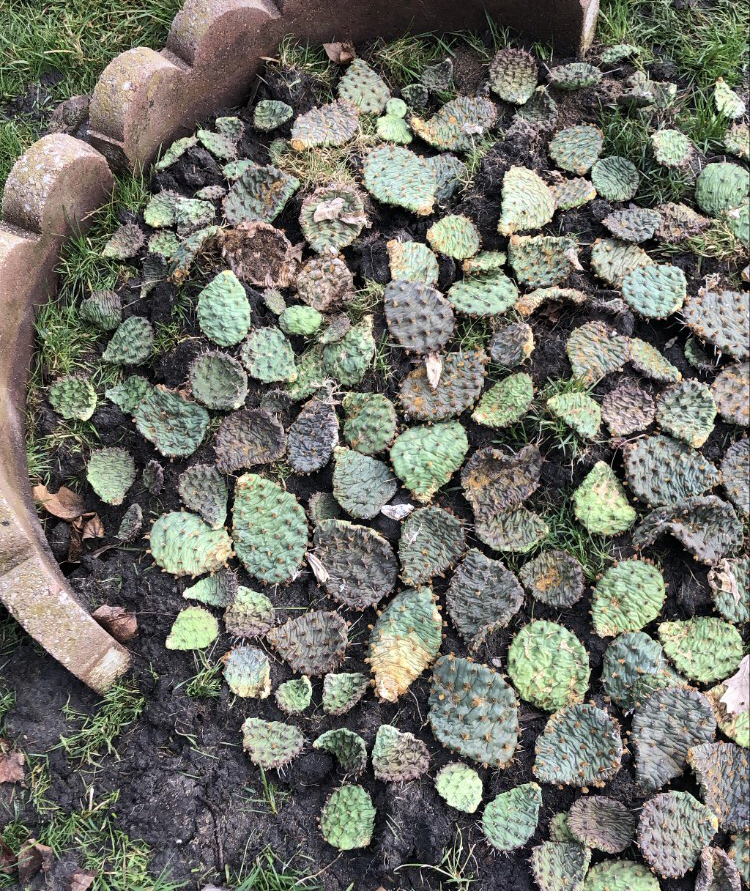
What do I need to do to have a Eastern Prickly Pear patch?
Last year I tried planting a bunch of prickly pears and it quickly turned into a weedy mess. It’s not easy picking weeds from a cactus patch.
How do I prevent weeds from growing in my cactus patch?
The picture attached is how I tried to grow them last year. I got a couple pads of growth but way to many weeds for it to look nice.
Thank you for contacting the Toronto Master Gardeners about Eastern Prickly Pear.
Please take a look at the following answer from one of our archived posts for further information on the conditions, propagation and cultural practices that will encourage your prickly pear to thrive:
Opuntia humifusa, commonly known as the Eastern Prickly Pear Cactus, is a perennial cactus that has rounded, jointed green pad segments on very short stems. It can grow either horizontal or upright, reaching heights of up to 18-24 inches. Like most cacti, these pads have very sharp bristles and spines which are used for defense purposes. The yellow flowers are somewhat waxy, are about 2-3 cm in diameter and form along the edges of the pads. The juicy, edible fruits are green, ripening to reddish-brown but in Ontario, fruiting is very rare.
This plant is native here in Ontario but has been endangered since April, 1985 with the last wild populations growing on the sand spits on the north shores of Lake Erie, including Point Pelee National Park. Because it grows in dry, sunny, sandy areas, these last wild populations are at risk from habitat loss primarily due to shoreline erosion from larger and more catastrophic storms, along with changes in vegetation as invasive species become more widespread.
Although these native wild plants are found mostly in sunny sand dunes and beach locations, cultivated plants purchased for the home garden will tolerate some shade (bright dappled sunlight throughout the day or late afternoon shade), but cannot grow in complete shade. Soil conditions should be sandy and well draining as these are succulents and do not like to have an abundance of moisture. Here in Ontario reproduction is chiefly done when smaller pads break off the parent plant and take root nearby so this is how you would propagate your plant. On the rare occasion that a flower does get pollinated, fruits and goes to seed, small mammals such as rabbits would be the main seed dispersal method.
So, find a location in your garden where you can provide the sunlight and soil conditions for it to thrive and plant it now. Before the first hard frost, mulch it well with straw or leaves in order to protect it from the freeze thaw cycles we sometimes experience. As the cactus pads retain a lot of moisture, these winter cycles can cause plants to split or become sun scalded so pile that mulch on as an insulator. In the spring, you can remove the mulch after the threat of a hard frost has passed. You may find small birds nest amongst the cactus as its spiky surface provides protection for young against predators.
The best way to discourage weeds from growing in your cactus patch is to mulch between and around your prickly pears including adding horticultural sand to the surface in and around your prickly pears. The sand will help you to pull weeds a bit more easily and will eventually go down and help a little with drainage. The sand will also discourage weeds from germinating on the surface of the soil. As note in another archived post, the use of mulch in this area and other parts of your garden has many benefits:
- A layer of mulch will help retain moisture, decreasing the amount of watering needed. It also will stop the surface of the soil from becoming hard and impenetrable from rain.
- The mulch will help smother weeds by depriving them of light so there is less weeding for you to do.
- The environment under the mulch will draw microbes and insects to the area. This will start to loosen up the soil and create aggregates which are essential for water retention and enable the plants to pull nutrients from the soil more efficiently. Minimizing digging will help your soil retain these aggregates. After a few years you will have much healthier soil in your garden.
- As the environment under the mulch becomes rich with microbes, fungi and insects the soil will loosen up and allow the roots of the plants to have better access to oxygen which is critical for plant health.
- The mulch can be left on the surface and new mulch added on top when the original mulch starts breaking down. As it breaks down it will release new nutrients into the soil.
There are a range of mulches that you can use from cedar bark, straw, leaves, horticultural sand, etc.
Hope this helps.

